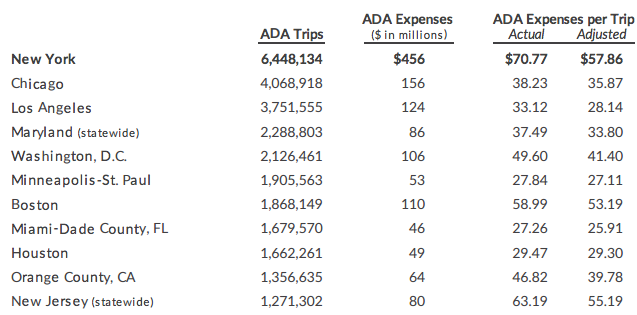
For customers, the price of a trip on Access-A-Ride, the MTA's service for New Yorkers with disabilities, is the same as a subway fare. But for the MTA, the cost of providing the service is much higher. At $72.65 per trip (the cost has risen since 2014, when the figures for the above table were compiled), Access-A-Ride is the most expensive paratransit system to operate in the nation. The high costs of the program eat into the MTA's ability to provide subway and bus service.
It doesn't have to be that way. The MTA can provide service for passengers with disabilities at much lower cost while improving the customer experience, according to a new report by the Citizens Budget Commission with support from TransitCenter [PDF].
The MTA began operating Access-A-Ride in the early 1990s, taking over a city program created after the Americans with Disabilities Act required "door-to-destination" service for people unable to access fixed-route subway and bus lines. As Access-a-Ride use grew in the first decade of the 2000s, costs more than doubled.
When the recession took out a big chunk of MTA revenues, the agency took steps to rein in Access-A-Ride costs by renegotiating contracts, tightening eligibility requirements, and increasing the use of taxis and livery vehicles instead of large vans. While the program isn't growing as fast as it was a few years ago, the cost per trip continues to escalate.

The CBC report, "Access-A-ride: Ways to Do the Right Thing More Efficiently," lays out strategies to reduce paratransit expenses by 40 percent, in part by building on the success of recent initiatives. The commission's recommendations fall under three categories: lowering the cost per trip, better managing demand, and shifting the source of revenue away from the MTA and the city.
Lower the Cost Per Trip

The biggest opportunity to cut the cost of each trip entails reducing the share of rides provide by dedicated service carriers operating specially-equipped Access-A-Ride vehicles.
More than half of Access-A-Ride trips are "ambulatory" -- i.e. for people who are able to walk to, enter, and exit vehicles without assistance. Vehicles with special equipment are not necessary for these trips. CBC estimates the MTA could save $126 million annually by shifting ambulatory trips to its broker car service program, which contracts with livery companies to dispatch vehicles for paratransit riders.
In addition, shifting all trips within the Manhattan "hail zone" (below 110th Street on the west side and below 96th Street on the east side) to yellow cabs, Uber, Lyft, and other on-demand e-hail services could save $28 million annually. That would also improve the customer experience, letting riders reserve sme-day trips, rather than a day in advance as the current system requires. CBC recommends that the MTA work with the Taxi and Limousine Commission to expand the wheelchair-accessible fleet of for-hire vehicles.
An overhaul of the MTA's contracting system would yield savings of $30 million. By contracting with a single, full-service broker to handle all relationships with vehicle providers, the MTA could streamline management of Access-A-Ride, encourage more competitive bidding, and lower administrative costs.
Better Manage Demand
Since 2002, the number of paratransit trips has grown at five times the rate of subway ridership, according to the report. The MTA projects that number to continue to rise at an annual rate of 6.5 percent.
Instead, the MTA should seek to maintain the 2015 trip volume, the CBC advises. The most effective way to do that would be to increase fares. Agencies are permitted to set the price of a paratransit ride at twice the price of a normal transit ride, but the MTA charges no premium -- its $2.75 paratransit fare is much lower than that of other cities. Bringing the MTA's paratransit fare in line with the fare in other cities could reduce the net cost of the program $86 million annually; maxing out the fare would reduce it by $184 million.
Separately, the MTA could encourage Access-A-Ride enrollees to use trains and buses. The MTA already provides free Metrocards to Access-A-Ride customers who request them, but this program has not been widely-publicized and is also slated for a roll-back to a mere half-price discount. The CBC argues that a well-publicized yet fraud-proofed version of the program could reduce the number of Access-A-Ride trips by 5 percent, yielding savings of $22 million annually.
Encouraging the use of "feeder service," which connects users to ADA-accessible train and bus stops, would reduce the number of trips taken while cutting the cost of trips completed. According to the report, feeder service is offered for only 1 percent of trip requests today. Increasing that to 5 percent would save another $20 million.
Shift the Revenue Mix

The vast majority of Access-A-Ride's funding comes from the MTA and the city of New York -- and the MTA expects those costs to increase significantly in the next few years. The report proposes possible savings of $14 million from increasing the state's Medicaid transit subsidy, which currently only covers the rider's fare, not the actual cost of providing the trip.





